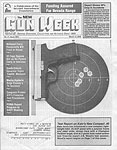
The Kahr P45: The Usual Kahr Precision Now in a Compact .45 Auto
The New Gun Week, March 2006 By J. B. Wood
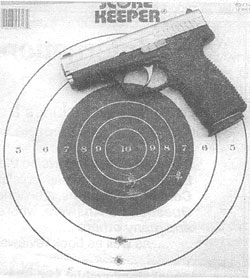 The P45 and a 25-yard target. The bottom two were the first shots, using a six o'clock hold. The other three shots resulted from a center hold.
The P45 and a 25-yard target. The bottom two were the first shots, using a six o'clock hold. The other three shots resulted from a center hold.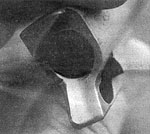 The offset ramp allows the trigger system to be placed higher in the frame.
The offset ramp allows the trigger system to be placed higher in the frame.
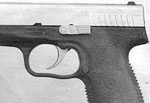 The Kahr controls are simple-slide latch and magazine release.
The Kahr controls are simple-slide latch and magazine release.
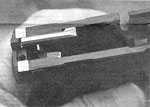 More simplicity: The roll-over sear, ejector, and the steel slide rails at the rear.
More simplicity: The roll-over sear, ejector, and the steel slide rails at the rear.
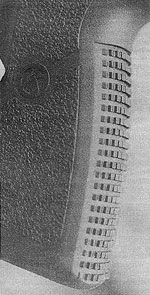 The front and rear of the grip frame have deep moulded checkering for a good hold.
The front and rear of the grip frame have deep moulded checkering for a good hold.Twelve years ago, in Dallas, TX, I was standing at a Shooting, Hunting and Outdoor Trade (SHOT) Show booth examining a compact 9mm pistol. At that point, I mentally added a name to my list of those under the heading "firearms genius:" Justin Moon. On the then-new Kahr Arms K9, everything was exactly right. I later visited the factory in Massachusetts, watching those precision-freaks make the gun, and found out why things stayed right.
The original K9 was followed by the K40, and soon after the even smaller Micro Series. Then, in 1999, polymer frames arrived. Through all of this time, the big-bore people were asking--how about a .45? Well, it's here, and with a lightweight polymer frame, designated the Kahr P45. The matte stainless slide on my test gun is also available in black finish.
Like the ones that came before it, the P45 has only two external controls--the magazine release button and the slide latch. Its double-action-only (DAO) trigger system requires no manual safety. The entire package is very flat, with all edges nicely rounded. With a Kahr, the concept of "improvement" is difficult, but in handling the new P45 I noticed one difference. On the earlier P9, the slide latch had considerable side projection. Not enough to snag, but it did stick out a bit. On the P45, this has been reduced by about half. It has good serrations, and is within easy thumb-reach, but it does not protrude. The push-button magazine release has the usual strong spring, to guard against inadvertent depression.
The characteristic slim configuration is maintained by the use of a single-row 6-round magazine, and in the magazine there is one notable little design touch. On the left side of the polymer follower, at the slide latch contact point, there is a small steel insert. There will be no chipping or wear of the polymer at that location.
The front and back of the grip frame have deep moulded checkering, and the shape is perfect for a good hold. The trigger guard is rounded at the front, with none of that "hook" stuff. (Does anyone still use that silly hold?) The trigger surface is smooth, as it should be on a DAO pistol. The pull is quick and easy. If you pull very slowly, there is a slight hesitation point that allows use of the sights.
The sights are square-picture, with a white dot on the front and a white square below the rear notch. (Across the Pond, they call this "Stavenhagen-pattern," named for a famed European shooter.) Both front and rear sights are dovetail-mounted, laterally adjustable by drifting. The rear notch has ample width for easy eye pick-up of the front sight.
Striker-Fired
The P45 is striker-fired, and the striker is blocked at all times, cleared only in the last bit of the trigger movement. The firing system is a reset-type, with the slide movement setting the striker in half-cock position. I prefer continuous-DA systems--but hey, how often do you get a sleepy primer, these days?
The locking system is a classic falling-barrel type; the barrel movement precisely controlled by an enclosed bent-oblong track in the underlug of the barrel. The feed ramp is slightly offset to the left (a patented feature), and this allows the trigger and trigger bar to be set higher in the frame, bringing the trigger finger closer to the axis of the bore.
Taking the P45 out for test-firing involved my usual sophisticated range equipment: a target stand and a shooting stick from MTM Case-Gard Company, and a comp stool. The backstop is the west bank of a drainage ditch. The distances were 25 yards (with the casual rest), and 7 yards (with a two-hand hold).
At 25 yards, the MagTech 230-grain full-jacket load grouped into 4 1/4 inches, with three (the last three) in the black. Actually, I was holding at six o'clock for the first two, then changed to a center-hold when I saw the impact area. The same thing was done with the Cor-Bon 165-grain JHP Plus-P, with similar results and a 2 1/2-inch group.
Moderate Recoil
For the other rounds fired, the felt recoil was moderate. The Cor-Bon load did cause this little 18.5-ounce pistol to come back with some force. A steady diet of that excellent Plus-P load could be detrimental to this fine gun. It certainly would be to my hand.
At 7 yards, with a two-hand hold, the CCI Blazer 200-grain JHP printed into 3 3/4 inches, well-centered. For this, I used the Champion VisiShot target; the hits turning orange against the black. Actually, it's a 100-yard Sight-In target, but I often use them for close-range handgun work. Note: The P45 had no problems with this "coffee-cup" hollowpoint.
At the same distance, same hold, the Federal 185-grain JHP delivered a neat little 2-inch group, just to the right of center, elevation perfect. This was not a great surprise, as I have found that this load in .45 seems to be inherently accurate. An aside for the 9mm shooters: The same remark applies to the 147-grain FMJ Subsonic load from Black Hills Ammunition.
The P45 is friendly to reloaders, tossing the empty cases 4 or 5 feet to the right rear. Well, that is, with all regular loads. With the Plus-P stuff, it did fling them a bit more wildly--but then, so does any other pistol. All of the regular cases were unmarked, but those of the Cor-Bon Plus-P load had a tiny dent on one side. With high-performance ammo, this is not unusual.
Of the six or seven "little" .45 pistols currently available, the Kahr is the lightest. How, then, did they manage to keep it from having excessive felt recoil? Several design factors are involved, and one of those is the frequently-used big word "ergonomics." The grip shape is exactly right, and the balance is perfect. The relatively high placement of the trigger also helps, as the slide and barrel are closer to the hand.
The P45 comes in a nice hard-polymer case with a spare magazine, safety lock, and instruction manual. Specifications for the P45 are: weight: 18.5 ounces; length: 6.3 inches; height: 5.25 inches; width: 1.1 inches; barrel length: 3.54 inches; magazine capacity: 6 rounds. The P45 with stainless slide and standard day sighs as reviewed here has an MSRP of $760; with optional tritium night sights add about $110. The black slide model has an MSRP of $791 with standard day sights, and $901 with the tritium night sights.
My favorite Kahr will always be the elegant T9. For the big-bore guys, though, the P45 is a welcome addition to the line-up. From the standpoint of the Bad Guys, a view of that cavernous muzzle may cause them to reconside any drastic action. If not, well, you'll know this high-quality pistol is going to work.
<< Go back to Previous Page